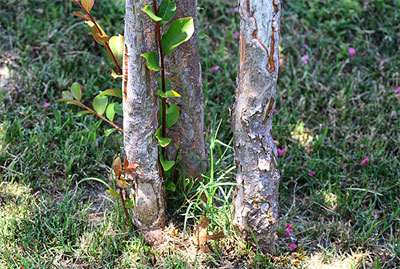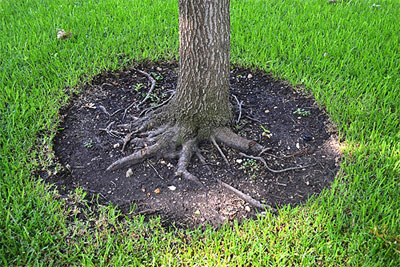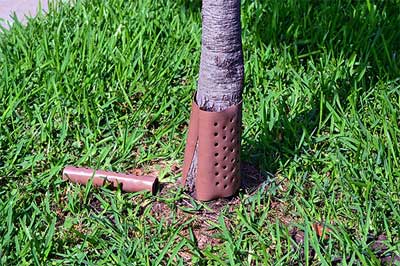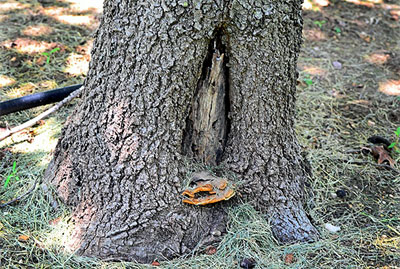Texas Tree Tips
Whack the Weeds — Not the Trees
With the onset of summer, it is important to note that the Number One enemy of trees, mechanical injury, is out in full force. Tree bark can be tough, but line trimmers and lawn mowers can inflict serious injury to trees. In severe cases, a valuable tree can die as a result of whacking the weeds or turf at the tree’s base. Just under the bark of a tree lies the vascular system that carries water and elements up and down the tree. A mechanical bark wound often seriously affects the vascular system and disrupts or prevents its normal function.

Mechanical injury from line trimmers and mower decks on this multi-trunk crape myrtle disrupts the flow of water and elements through the tree’s vascular system and creates unwanted stress. Photos provided by Bill Seaman.
Although it is tempting to blame line trimmers or lawnmowers as the culprits, it is more accurate to blame the equipment operator. An equipment operator can be over-zealous and damage a tree. And should turf really be growing at the base of a tree?

Mechanical damage to trees can be reduced by carefully removing the turf grass near the trunk. Complete the process by adding a 2-inch layer of mulch to protect exposed surface roots.
Many gardeners would say lawn grasses growing up to the base of a tree is attractive, and “turf is king.” However, trees grow best in a natural environment or with organic material (leaves and mulch) around their bases as well as out to the ends of the limbs. Turf in this area competes with tree roots for elements and water.
Due to the natural process of ecosystem succession, turf and sun-loving smaller plants near the base of a tree are lost over time as the tree (or nearby trees) produce more sun-blocking shade. However, our urban landscapes are seldom allowed to follow the process of natural succession as trees and plants grow. The result is an attempt to keep the turf at the base of a tree forever or risk the neighbors thinking you are one of those “tree hugger” types.
To be painfully honest, trees, as well as arborists, are not very fond of turf. In all fairness, turf aficionados are not very fond of trees either. Ask an arborist to remove a healthy tree so more sunlight can reach the grass — or a good turf devotee to remove all the turf for the health of a tree — and watch the fur fly.
Recently planted trees with young and thin bark are much more susceptible to mechanical injury than their older, corky-barked counterparts. New trees should have mulch around them with no weeds or turf as competition for four to five years, if possible. This practice requires hand weeding or using other methods to manage competing plant growth.

Vinyl trunk guards can be placed around the base of newly planted trees to protect them from mechanical injury. Perforated guards allow for air circulation so the protected bark can remain dry between rains and waterings.
If you must grow turf at the base of the tree, keep it maintained at least 3 inches away from the trunk. If you are worried about an over-zealous weed whacker, a vinyl tree guard can be used around the base of the tree to protect it from line trimmers and mower decks. There are a number of suitable products that are designed to wrap and protect the base of a new tree from mechanical injury. Although they can be effective, any covering of the bark creates a shady condition, and once it is removed, “sunscald” or sun damage to the trunk can ensue. If you must use a tree guard, take it off in the early fall, when the sunlight is less intense. In general, it is better to have mulch around the base of young trees or keep the turf back from the trunk to avoid the need for a protective covering.
Shade and ornamental trees with smooth bark that can easily be damaged by mechanical injury include crape myrtles, hollies, lacebark elms, western soapberries, red oaks, bald cypress, maple, and Eve’s necklace.

While this 15-year-old red oak works to heal old mechanical damage, the injury has provided a site for fungal pathogens (mushroom-like growth at base of wound) and boring insects to enter the tree.
One final word of caution — injury to any part of a tree can create an entrance for diseases and insects. As your tree-security advisor, I encourage you to please lock your doors to keep out these bad guys.
About the author: Steve Houser is a Dallas native with more than 30 years of experience as a consulting arborist and tree climber. He is the president of Arborilogical Services Inc., “The Experts Your Trees Deserve.” www.arborilogical.com.

